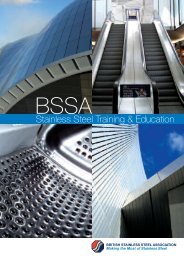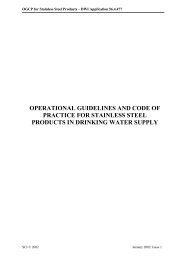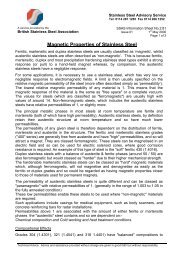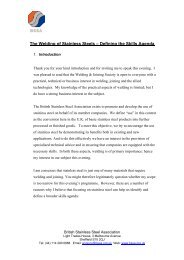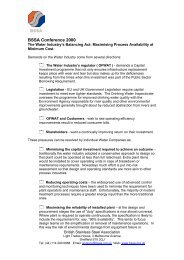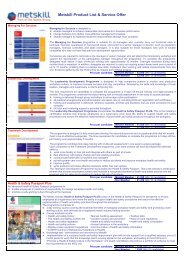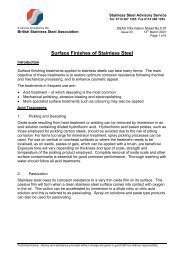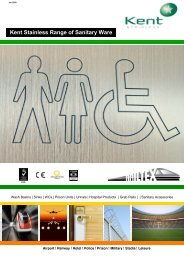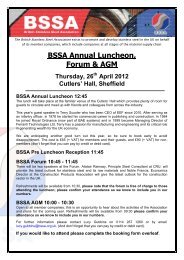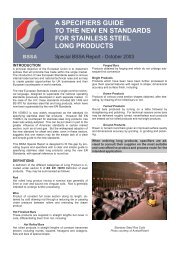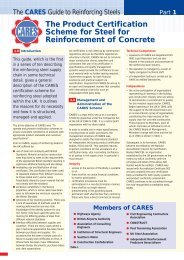EN 10259 - British Stainless Steel Association
EN 10259 - British Stainless Steel Association
EN 10259 - British Stainless Steel Association
Create successful ePaper yourself
Turn your PDF publications into a flip-book with our unique Google optimized e-Paper software.
<strong>Stainless</strong> <strong>Steel</strong> Advisory Service<br />
Tel: 0114 267 1265 Fax 0114 266 1252<br />
A service provided by the<br />
SSAS Information Sheet No.2.51<br />
<strong>British</strong> <strong>Stainless</strong> <strong>Steel</strong> <strong>Association</strong> Issue 02 21 st March 2001<br />
Page 1 of 5<br />
Tolerances for Cold-Rolled Wide <strong>Stainless</strong> <strong>Steel</strong> Strip<br />
(<strong>EN</strong> <strong>10259</strong>)<br />
With the publication of <strong>EN</strong> <strong>10259</strong> in May 1997, there now exists a complete set of Europewide<br />
dimensional tolerance standards for flat rolled stainless products, as follows: -<br />
<strong>EN</strong> 10029<br />
<strong>EN</strong> 10048<br />
<strong>EN</strong> 10051<br />
<strong>EN</strong> 10258<br />
<strong>EN</strong> <strong>10259</strong><br />
Hot rolled steel plates 3mm thick or above – Tolerances on dimensions<br />
shape and mass (i.e. quarto plate)<br />
Hot rolled narrow steel strip – Tolerances on dimensions and shape<br />
(i.e. hot rolled narrow strip)<br />
Continuously hot rolled uncoated plate, sheet and strip of non-alloy and<br />
alloy steels – Tolerances on dimensions and shape<br />
(i.e. continuously hot rolled strip)<br />
Cold rolled stainless steel narrow strip and cut lengths – Tolerances on<br />
dimensions and shape<br />
(i.e. cold rolled narrow strip)<br />
Cold rolled stainless steel wide strip and plate/sheet – Tolerances on<br />
dimensions and shape (i.e. cold rolled wide strip)<br />
This set of standards is part of the ongoing process of replacing member state national<br />
standards, as part of developing the European Union single market. <strong>British</strong> Standards<br />
replaced were unusual in having the dimensional tolerance requirements within each<br />
product standard, whereas the <strong>EN</strong> tolerance standards apply to all appropriate product<br />
standards and will be referenced there.<br />
Table 1 shows a list of some of the existing and proposed product standards to which <strong>EN</strong><br />
<strong>10259</strong> can be applied.<br />
This Information Sheet is only intended to be an outline and is not intended, nor should be<br />
used as a substitute for the standards discussed<br />
Technical Advice: Advice and assistance provided without charge are given in good faith but without responsibility
SSAS Information Sheet No.2.51<br />
Issue 02 21 st March 2001<br />
Page 2 of 5<br />
Specific Features of <strong>EN</strong> <strong>10259</strong> Tolerances<br />
Thickness Tolerance<br />
Preferred thicknesses are shown and are intended to indicate which gauges are more<br />
likely to be available on an ex-stock basis from suppliers. Buyers of other thicknesses may<br />
be required to purchase full coil weight quantities.<br />
Compared with the <strong>British</strong> Standard tolerances, <strong>EN</strong> <strong>10259</strong> has the following differences: -<br />
1. Tolerances are given up to 6.5mm thick, rather that finishing below 3.0mm.<br />
2. There is a ‘normal’ tolerance and also a ‘special’ tolerance at some thicknesses and<br />
widths. The ‘special’ range is about 70% of the normal range, and also symmetrical<br />
about the nominal. The <strong>British</strong> Standards have only one range.<br />
3. In <strong>EN</strong> <strong>10259</strong>, the range varies a little across 3 groups of ordered widths, whereas the<br />
old BS tolerances did not vary with the width.<br />
4. The new ‘normal’ ranges are close to the BS ranges.<br />
5. Purchasers who wish to order ‘special’ thickness tolerances should enquire about their<br />
availability with the supplier. There may be some restrictions associated with these<br />
tolerances.<br />
Width Tolerance<br />
Width tolerances are all positive, unlike the standards replaced that had equal plus and<br />
minus tolerances.<br />
<strong>EN</strong> <strong>10259</strong> has both "normal" and "special" ranges, the special tolerances being closest to<br />
those in the standards replaced, so if the "old" width tolerances are required, then the<br />
<strong>EN</strong><strong>10259</strong> special tolerances should be specified.<br />
Length Tolerance<br />
Length tolerances also have both "normal" and "special" tolerance ranges. "Special"<br />
tolerance should be specifically requested. Each range is proportional to the length of the<br />
sheet or cut length, with a minimum tolerance at 2000mm length. Unlike the old<br />
standards, these tolerances apply for any length that can be supplied, and across the<br />
whole thickness range.<br />
Flatness and Edge Waviness Tolerances<br />
In contrast to the standards replaced, <strong>EN</strong> <strong>10259</strong> introduces tolerances for flatness of<br />
sheet, plate and cut lengths, with both a "normal" and "special" range. There is a larger<br />
tolerance range above 3000mm lengths. This greater tolerance applies also to strip, for<br />
which there is also a limitation of edge waviness.<br />
Technical Advice: Advice and assistance provided without charge are given in good faith but without responsibility
SSAS Information Sheet No.2.51<br />
Issue 02 21 st March 2001<br />
Page 3 of 5<br />
Out-Of-Squareness and Edge Camber<br />
<strong>EN</strong> <strong>10259</strong> and the old <strong>British</strong> Standards take different approaches. The old standards<br />
specified that the nominal rectangular ordered dimensions (the ‘ordered format’) must be<br />
capable of being inscribed within the actual pieces supplied. <strong>EN</strong> <strong>10259</strong> allows this as an<br />
option, which may be specifically requested. If requested the tolerances on width, length,<br />
out-of-square and edge camber can be re-negotiated.<br />
However, as the principal method of control, the <strong>EN</strong> defines the limit of out-of-squareness<br />
in two alternative ways, either through the difference in diagonal lengths, or by a direct<br />
measurement of the deviation from rectangular shape.<br />
In a similar way, the <strong>EN</strong> defines limiting edge camber of sheets, plates and cut lengths,<br />
measured over either a 1000mm or 2000mm length. The old standards did not specify<br />
edge camber limits.<br />
Measurement Methods<br />
The <strong>EN</strong> is more precise in that measurement instructions are given for each parameter. In<br />
most cases, this documents what has been done for some time.<br />
Ordering <strong>Steel</strong> using <strong>EN</strong> <strong>10259</strong><br />
The new standard sets out a concise and logical way of defining your requirements with<br />
respect to dimensions and is recommended as it ensures that nothing is left out.<br />
The same general method appears in all European standards, the steps involved being<br />
defined below, followed by some examples (Table numbers are those in the actual<br />
standard)<br />
1. Although it does not say so in the standard, the first item is the weight or number of<br />
pieces required e.g. 100 sheets or 3 tonnes.<br />
2. Type of product means: - wide strip, slit strip, plates, sheet or cut lengths.<br />
3. Next comes the number of this standard – <strong>EN</strong> <strong>10259</strong>.<br />
4. Next is the nominal thickness in mm remembering that thickness tolerances given in<br />
table 1 are equally +/-.<br />
5. If special thickness tolerances are required (Table 1), on material less than 2mm thick,<br />
indicate this using "S", otherwise the material will be supplied to normal thickness<br />
tolerances.<br />
6. The nominal width in mm is next, remembering that all width tolerances are positive,<br />
unless specially agreed otherwise.<br />
7. If special width tolerances are required (Table 2), on material no wider than 600mm,<br />
indicate this using "S" after the width, otherwise normal width tolerances will be used<br />
8. For plates, sheets and cut lengths, next put the nominal length in mm, remembering<br />
that all length tolerances are positive.<br />
9. If special length tolerances are required (Table 3) indicate this using "S", otherwise<br />
normal length tolerances will be used.<br />
Technical Advice: Advice and assistance provided without charge are given in good faith but without responsibility
SSAS Information Sheet No.2.51<br />
Issue 02 21 st March 2001<br />
Page 4 of 5<br />
10. If special flatness tolerances are required, as described in clause 10, indicate this using<br />
"FS", otherwise normal tolerance will be supplied.<br />
11. Finally, add any extra dimensional requirements, before describing the steel grade and<br />
finish, certification and any other technical requirements. It is suggested that the <strong>EN</strong><br />
10088 steel number be used, rather than the name, when ordering, as this is more<br />
widely used & understood.<br />
An example of the "order" format is: -<br />
10 tonnes of wide strip <strong>EN</strong> <strong>10259</strong>-1,20x1250<br />
<strong>Steel</strong> <strong>EN</strong> 10088-2-1.4301+2B<br />
When specifying 10 tonnes of wide strip, with nominal thickness 1.20mm and normal<br />
thickness tolerance, nominal width 1250mm in steel with name X5CrNi18-10 and number<br />
1.4301 and process route 2B, all as specified in <strong>EN</strong> 10088-2.<br />
Advantages of the <strong>EN</strong> tolerance standards<br />
<strong>EN</strong> <strong>10259</strong> has the following benefits over the previous requirements in the obsolete<br />
standards BS 1501-3 and BS 1449-2<br />
1. It quite clearly applies to all product forms cut from cold rolled wide strip i.e. strip rolled<br />
to a width of 600mm or more. It therefore covers wide strip, sheet, plate, slit strip and<br />
cut lengths of whatever final width or length.<br />
2. It clearly does not apply to cold rolled narrow strip or products cut from narrow strip,<br />
with a rolling width of less than 600mm, for which <strong>EN</strong> 10258 exists. This narrow strip is<br />
also called precision strip.<br />
3. It recognises that cold rolled products are now available up to 6.5mm thick and<br />
2100mm wide.<br />
4. Although the European and <strong>British</strong> definition of the boundary between ‘plate’ and<br />
‘sheet’ is at 3mm, the tables cover the whole range, and don’t depend on this<br />
distinction.<br />
5. It includes systematic requirements for flatness, out-of-squareness and edge camber.<br />
6. It describes the measurement method(s) for each parameter.<br />
7. For most parameters, there is a ‘normal’ requirement, plus alternative ‘special’<br />
requirement.<br />
8. Widespread adoption of this standard throughout Europe will enable producers to<br />
manufacture in a more consistent way, giving greater flexibility to supply across<br />
Europe, leading to shorter lead times with lower stocks, but faster, more flexible<br />
response.<br />
9. Dimensional standardisation will help satisfy customers throughout Europe.<br />
10. The standard offers a concise method of defining purchase requirements, so reducing<br />
the risk of doubt or confusion.<br />
Technical Advice: Advice and assistance provided without charge are given in good faith but without responsibility
SSAS Information Sheet No.2.51<br />
Issue 02 21 st March 2001<br />
Page 5 of 5<br />
Table1 - Product Standards which Reference <strong>EN</strong> <strong>10259</strong><br />
General purposes product standards<br />
<strong>EN</strong> 10088-2 <strong>Stainless</strong> <strong>Steel</strong>s – Part 2 Technical delivery conditions for<br />
sheet/plate and strip for general purposes<br />
<strong>EN</strong> 10095 Heat resisting steel and nickel alloys (‘stainless’ steels and<br />
nickel alloys)<br />
pr<strong>EN</strong> 10302 Creep resisting steels and nickel alloys<br />
Pressure Purposes Product Standards<br />
<strong>EN</strong> 10028-1 Flat products made of steel for pressure purposes – Part 1:<br />
General requirements<br />
<strong>EN</strong> 10028-7 Flat products made of steel for pressure purposes – Part 7:<br />
<strong>Stainless</strong> <strong>Steel</strong>s (includes plates, hot and cold rolled<br />
sheet/plate and strip)<br />
This Information Sheet is an update of BSSA Information Sheet No.8<br />
Technical Advice: Advice and assistance provided without charge are given in good faith but without responsibility



